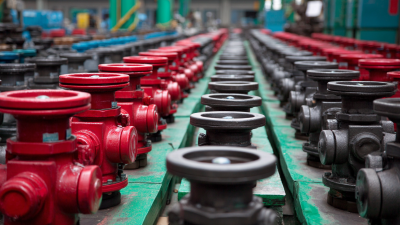
In the dynamic world of fluid management, the importance of choosing the right sight flow indicator cannot be overstated. According to industry reports, the global flow indicator market is expected to reach approximately $2 billion by 2025, driven by increasing demand across various sectors, including oil and gas, pharmaceuticals, and water treatment. A sight flow indicator plays a crucial role in providing visual confirmation of flow rate and fluid clarity, which is essential for maintaining optimal operational efficiency and safety. However, with a plethora of options available on the market, selecting the best sight flow indicator tailored to specific needs can be a daunting task. This ultimate guide will delve into the functionalities, types, and key considerations to help you make an informed decision, ensuring that your fluid management processes remain seamless and efficient.

Sight flow indicators are essential tools for monitoring the flow of liquids and gases in various industrial applications. Understanding the types of sight flow indicators available—such as transparent, reflex, and illuminated—allows users to choose the right one for their specific needs. According to a report from Allied Market Research, the global market for flow measurement devices, including sight flow indicators, is projected to reach $7.6 billion by 2027, underscoring the increasing reliance on these devices in process industries.
When selecting a sight flow indicator, consider the application environment. For instance, transparent indicators are ideal for clean and clear liquids, while reflex indicators are beneficial for applications involving colored or opaque fluids. Additionally, illuminated sight flow indicators enhance visibility in low-light conditions, ensuring accurate monitoring. **Tip:** Always match the material of the sight flow indicator with the fluid's chemical properties to prevent corrosion and ensure longevity.
Another important aspect is the installation and maintenance of these indicators. Proper installation can minimize the risks of leaks and ensure optimal performance. Regular maintenance checks, as recommended by industry experts, can help in identifying any issues early and prolonging the life of the indicator. **Tip:** Schedule periodic inspections and cleanings based on the manufacturer's guidelines to maintain accuracy and efficiency in flow measurement.

When selecting a sight flow indicator for your system, several key factors come into play to ensure it meets your operational needs effectively. Firstly, you should consider the material compatibility of the indicator with the fluids in your system. Depending on the nature of the fluids—whether they are corrosive, abrasive, or viscous—different materials such as glass, acrylic, or stainless steel may be more appropriate. Ensuring compatibility will prolong the life of the indicator and maintain the integrity of your process.
Another crucial factor is the flow rate and visibility requirements. Some applications may require high flow rates, necessitating indicators designed to handle such conditions without losing visibility. The design and size of the sight flow indicator are important too; larger transparent sections can enhance visibility but may also require additional space in installations. Additionally, consider whether you need additional features such as backlighting or integrated flow alarms, which can provide immediate feedback and enhance monitoring capabilities in operational processes.
When it comes to choosing the right sight flow indicator for industrial applications, understanding the differences between glass and plastic options is crucial. Glass sight flow indicators are known for their clarity and durability, making them an excellent choice for high-temperature and high-pressure applications. They resist oxidative agents and provide a clear view of the fluid flow, enabling precise monitoring. However, they can be more prone to breakage compared to their plastic counterparts, which are lighter and generally more resistant to impacts.
Plastic sight flow indicators, on the other hand, offer greater flexibility and are often more affordable. They are a popular choice in environments where the risk of shattering glass is a concern. Nevertheless, it's important to consider the chemical compatibility of the plastic material with the fluids being processed, as some plastics may degrade when exposed to certain chemicals.
**Tips:** Always check the specifications for the maximum pressure and temperature ratings of both glass and plastic indicators before making your selection. Additionally, consider the type of fluid and its chemical properties to ensure compatibility with your chosen material. Regular maintenance and cleaning will also prolong the life of whichever indicator you choose, ensuring that you maintain optimal visibility and functionality.

Choosing the right size and material for your sight flow indicator is crucial for achieving optimal performance in your specific applications. The size of the sight flow indicator should align with the flow rate and pipe diameter of your system. A properly sized indicator ensures accurate flow readings and minimizes pressure drops, which can lead to inefficiencies in your operations. For example, larger indicators are often necessary for higher flow rates, while smaller indicators may suffice for lower volumes. It’s important to consult data related to your system's specifications, as this can significantly impact functionality.
Material selection is another vital aspect to consider. Different materials offer various levels of resistance to chemicals, temperature, and pressure. For instance, stainless steel is preferred in corrosive environments, while glass indicators are ideal for applications requiring visual clarity. Additionally, certain plastics may be beneficial for lightweight and non-corrosive applications. Analyzing the chemical composition of the fluid, as well as operational temperature and pressure ranges, will guide you in selecting the most suitable material. By taking a data-driven approach, you can ensure your sight flow indicator not only meets your needs but also enhances operational efficiency.
Maintaining sight flow indicators is crucial for ensuring their longevity and reliable operation in various industrial settings. According to a recent report by the International Society of Automation, improper maintenance can lead to a significant decrease in the lifespan of these critical devices, potentially reducing their functionality by over 30%. Routine inspections, including checking for leaks and ensuring proper calibration, can help avoid costly downtimes and replacements.
Additionally, it is essential to use compatible cleaning agents and procedures during maintenance to prevent degradation of materials used in sight flow indicators. A study by the American Society of Mechanical Engineers indicates that indicators exposed to harsh chemicals without proper cleaning protocols experience a 40% higher failure rate. Implementing best practices, like regular training for maintenance personnel and adhering to manufacturer guidelines, can ultimately enhance operational efficiency and prolong the lifespan of sight flow indicators, ensuring they perform optimally under various operational conditions.





